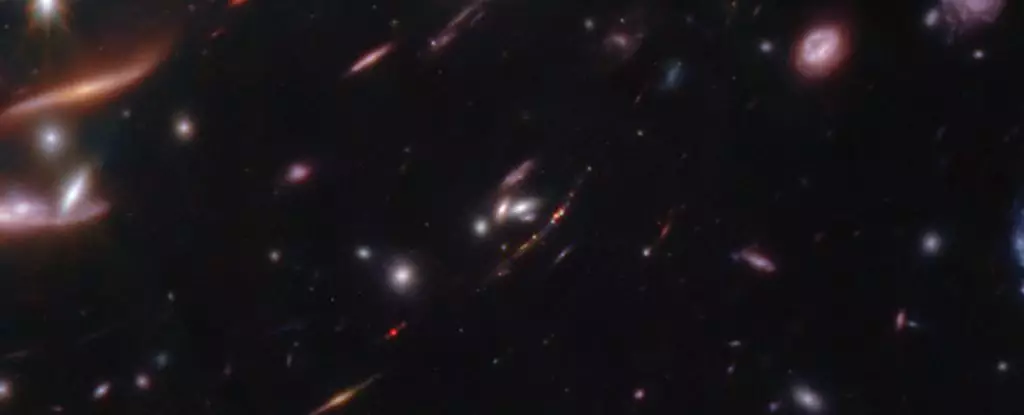In the vast expanse of the cosmos, a remarkable discovery has emerged—an infant galaxy, dubbed “Firefly Sparkle,” providing invaluable insights into the conditions of the early universe. Located approximately 600 million years after the Big Bang, this galaxy serves as an analog for what our own Milky Way may have looked like during its nascent stages. Bursting with stellar formations, Firefly Sparkle is not only a visual wonder but a significant subject of study for astronomers aiming to unfold the mysteries of cosmic evolution.
Utilizing advanced observational technology, scientists are peering deep into the past, tracing back over 13.2 billion years. The light from Firefly Sparkle reached Earth through a complex interplay of gravitational lensing and cutting-edge telescopic capabilities. The James Webb Space Telescope (JWST)—the most sophisticated instrument of its kind—enabled astronomers to capture detailed images of this distant galaxy. With it, they could resolve 10 distinct star clusters within Firefly Sparkle’s shimmering embrace, revealing crucial details about its mass and the processes driving star formation.
The early universe, particularly within the first billion years, is a focal point for researchers exploring cosmic history. This epoch, termed the Cosmic Dawn, marked the transformative era where hydrogen and helium, remnants of the Big Bang, began to coalesce into the first stars and galaxies. However, peering into this period presents significant challenges; distance and the vastness of space render most celestial objects mere blurs of light.
Gravitational lensing, a phenomenon where massive celestial objects warp the fabric of space-time, offers a solution to this observational conundrum. Much like a gigantic lens, a massive galaxy cluster can bend and amplify the light from more distant objects, enabling astronomers to capture the otherwise faint glimmers from the far reaches of the universe. Thus, Firefly Sparkle was revealed to us through the magnifying effect of a foreground galaxy cluster, whose massive gravitational field allowed us to perceive details that would otherwise remain hidden.
The intricate process of light reconstruction enabled scientists to visualize the structure of Firefly Sparkle. The resulting imagery depicts a galaxy reminiscent of a blooming teardrop, with star-forming clumps encircled by diffuse light from other unresolvable stars. This detailed analysis unveiled that star formation within the galaxy is neither uniform nor simultaneous; rather, different clusters exhibit various colors and characteristics, indicating they are at different stages of stellar evolution.
Astrophysicists like Lamiya Mowla express astonishment at the results, acknowledging the unexpected clarity with which they can observe the mass of Firefly Sparkle and its star-forming habits. Unlike expectations of uniformity, the presence of clusters at different developmental phases suggests a dynamic and complex assembly process—one akin to the mechanisms driving galactic formation throughout the universe.
In addition to the internal dynamics of Firefly Sparkle, its external landscape also offers clues about galactic evolution. Nearby galaxies, situated merely 6,500 and 42,000 light-years away, hint at a gravitational interplay that may facilitate further growth. This proximity suggests a shared evolutionary path, indicative of the cannibalistic nature of galaxy formation prevalent in the early universe. As smaller galaxies interact and merge, they contribute to the mass and structure of larger entities—an action similar to the formative years of our own Milky Way.
The insights garnered from Firefly Sparkle bolster existing theories regarding the amalgamation and growth processes of galaxies in the cosmos. Researchers, including Yoshihisa Asada, emphasize the importance of these interactions, reinforcing predictions that such processes were commonplace in the universe’s formative stages.
Firefly Sparkle offers an unprecedented window into the past, presenting a detailed understanding of how galaxies like our Milky Way may have formed. However, this discovery is only the beginning. As astronomers continue to harness the capabilities of JWST and gravitational lensing, the frequency of such findings is likely to rise. The implications extend beyond mere observation; they deepen our comprehension of the universe’s evolution, providing context for both our origins and the nature of cosmic structures.
The study of Firefly Sparkle is a remarkable reminder of the complexities inherent in galaxy formation and evolution. By merging cutting-edge technology with theoretical frameworks, the scientific community inches closer to unraveling the enigmatic history of the universe we inhabit. As our observational tools grow ever more sophisticated, so too does our understanding of the cosmos, paving the way for future explorations that might illuminate the paths of countless other stars, galaxies, and the very fabric of existence itself.


Leave a Reply